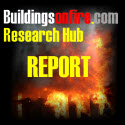USFA Releases Restaurant Building Fires Report
By Christopher J. Naum, SFPE on Apr 16, 2011 with Comments 0
The Federal Emergency Management Agency’s (FEMA) United States Fire Administration (USFA) has issued a special report examining the characteristics of restaurant building fires.
The report, Restaurant Building Fires, was developed by USFA’s National Fire Data Center and is based on 2007 to 2009 data from the National Fire Incident Reporting System (NFIRS).
 Restaurant Building Fires http://www.usfa.dhs.gov/downloads/pdf/statistics/v12i1.pdf
Restaurant Building Fires http://www.usfa.dhs.gov/downloads/pdf/statistics/v12i1.pdf
- An estimated 5,900 restaurant building fires occur annually in the United States, resulting in an estimated average of 75 injuries and $172 million in property loss.
- The leading cause of all restaurant building fires is cooking at 59 percent and nearly all of these cooking fires (91 percent) are small, confined fires with limited damage.
- While cooking is the leading cause of all restaurant building fires as well as the smaller, confined restaurant building fires, electrical malfunction is the leading cause of the larger, nonconfined restaurant building fires.
- Nonconfined restaurant building fires most often start in cooking areas and kitchens (41 percent).
- Deep fryers (9 percent), ranges (7 percent), and miscellaneous kitchen and cooking equipment (5 percent) are the leading types of equipment involved in ignition in nonconfined restaurant building fires.
- Smoke alarms were reported as present in 44 percent of nonconfined restaurant building fires. In addition, full or partial automatic extinguishment systems, mainly sprinklers, were present in 47 percent of nonconfined restaurant building fires.
Restaurant Building Fires is part of the Topical Fire Report Series. Topical reports explore facets of the U.S. fire problem as depicted through data collected in NFIRS.
Each topical report briefly addresses the nature of the specific fire or fire-related topic, highlights important findings from the data, and may suggest other resources to consider for further information. Also included are recent examples of fire incidents that demonstrate some of the issues addressed in the report or that put the report topic in context.
Additional Insights and Links
- NIOSH REPORT: Restaurant Fire Claims the Life of Two Career Fire Fighters – Texas, 2000 HERE
Operational Safety Recommendations
NIOSH investigators concluded that, to minimize the risk of similar incidents, fire departments should
- ensure that the department’s Standard Operating Procedures (SOPs) are followed
- ensure that fire command always maintains close accountability for all personnel at the fire scene
- ensure that Incident Command conducts an initial size-up of the incident before initiating fire fighting efforts and continually evaluates the risk versus gain during operations at an incident
- ensure that vertical ventilation takes place to release any heat, smoke, and fire
- ensure that fire fighters are trained to identify truss roof systems
- ensure that fire fighters use extreme caution when operating on or under a lightweight truss roof and should develop standard operating procedures for buildings constructed with lightweight roof trusses
- ensure that fire fighters performing fire fighting operations under or above trusses are evacuated as soon as it is determined that the trusses are exposed to fire
- explore using a thermal imaging camera as a part of the exterior size-up
- ensure that, whenever there is a change in personnel, all personnel are briefed and understand the procedures and operations required for that shift, station, or duty
- ensure that, whenever a building is known to be on fire and is occupied, all exits are forced and blocked open
- consider providing all fire fighters with portable radios or radios integrated into their face pieces
- consider adding additional staff in accordance with NFPA standards
- establish various written standard operating procedures, ensure record keeping, and conduct annual evaluations to monitor and evaluate the effectiveness of their overall SCBA maintenance program.
Additionally, building owners, utility providers, and municipalities should
- ensure that all exterior building utilities are accessible and in working condition
- consider placing the building’s construction information on an exterior placard
- upgrade or modify older structures to incorporate new codes and standards to improve occupancy and fire fighter safety
Filed Under: Research Hub • Statistics & Data



























